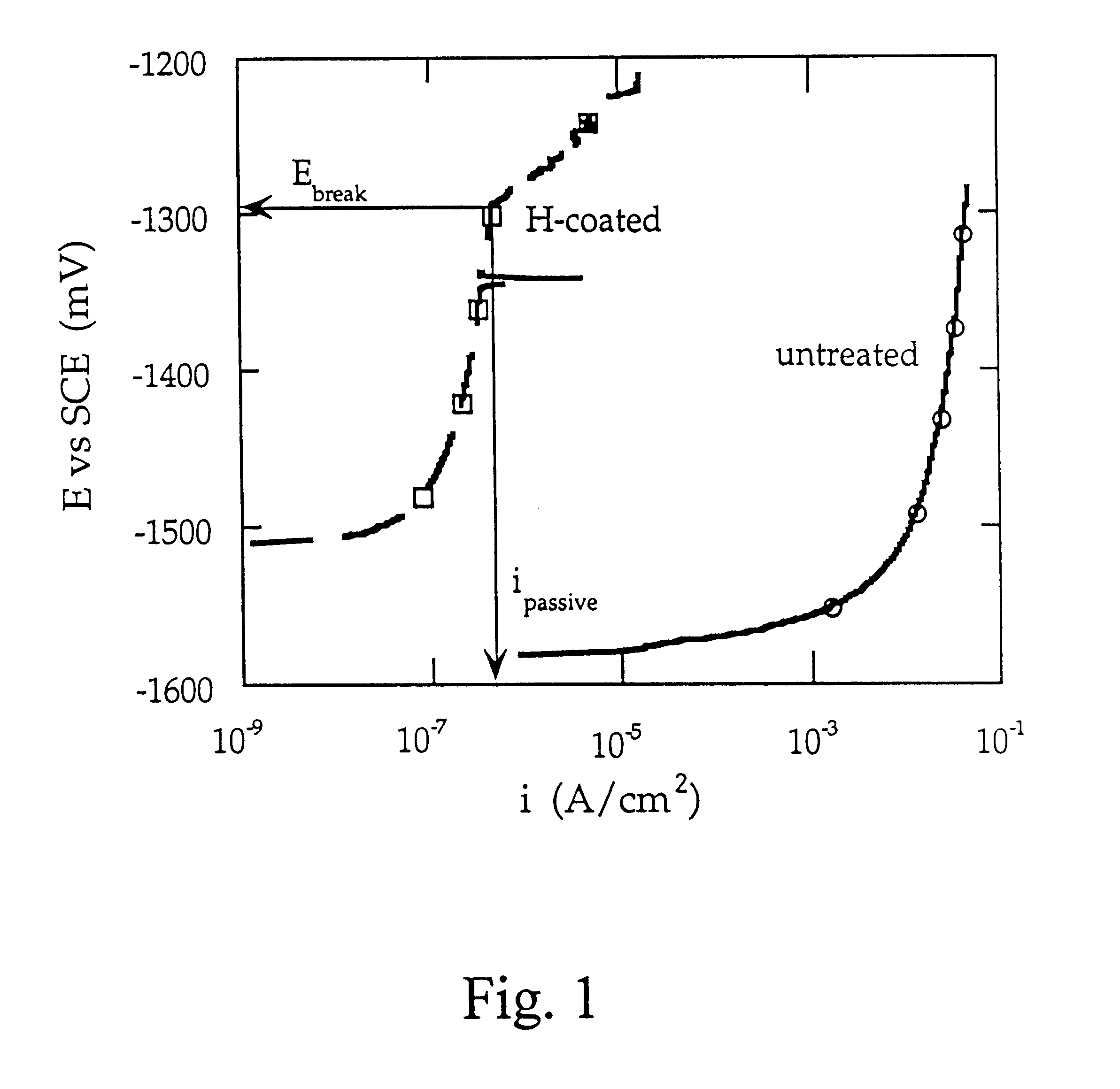Cathodic protective coating on magnesium or its alloys
a protective coating and cathode technology, applied in the direction of coatings, natural mineral layered products, chemistry apparatus and processes, etc., can solve the problems of limited corrosion protection, solution and disposal, and achieve the effect of reducing the risk of corrosion
- Summary
- Abstract
- Description
- Claims
- Application Information
AI Technical Summary
Benefits of technology
Problems solved by technology
Method used
Image
Examples
example 1
For this example, two diecast test specimens of magnesium alloy AZ91D were used. After mechanical polishing and degreasing with acetone, specimens were immersed in 10 wt% HF solution for 30 seconds. Thereafter, one of the specimens was treated by the method of the present invention using the following operating conditions:
Bath solution composition: 0.01 M NaOH+0.2 M Na.sub.2 SO.sub.4
pH.apprxeq.12
Bath solution temperature: 60.degree. C.
Current input: intermittent cathodic current
Amplitude: -50 mA / cm.sup.2
Frequency: 0.5 Hz
Duration: 2 hours
The two specimens, one treated as indicated above, and the other untreated were immersed in 5 wt % NaCl solution saturated with Mg(OH).sub.2 for 21 days. The weight loss corrosion rate of the specimens was evaluated after removing the corrosion products by CrO.sub.3 solution. The result of the immersion test is shown in the following Table 2.
It is seen from the above results that the corrosion rate of the specimen treated in accordance with this inve...
example 2
The paintability of the novel treatment compared to other surface finishing methods was evaluated using AZ91D diecast test plates. Prior to the treatment, the surface was polished with #600 emery paper and degreased with acetone. Acid etching with 10 wt % HF solution was conducted for 30 seconds. Some test plates were left untreated while others were treated pursuant to the present invention using the following operating conditions:
Bath solution composition: 0.01M NaOH+0.2 M Na.sub.2 SO.sub.4
pH.apprxeq.12
Bath solution temperature: 60.degree. C.
Current input: intermittent cathodic current
Amplitude: -50 mA / cm.sup.2
Frequency: 0.5 Hz
Duration: 30 minutes
For comparison, dichromate treatment (chemical treatment No. 7; MIL-M-3171, Type III) and modified chrome pickle treatment (chemical treatment No. 20) were applied according to the standard procedure (ASM Metal Handbook vol. 5, p. 824 (1994)). An acrylic based powder coating was applied to treated specimens, following the baking at 204.de...
example 3
For this example, AZ91D diecast test specimens were used. After mechanical polishing and degreasing with acetone, specimens were immersed in 10 wt % HNO.sub.3 solution for 10 seconds. The specimens were then treated by the method of the present invention under the following operating conditions:
Bath solution composition: 0.01 M NaOH+0.1 M Na.sub.2 SO.sub.4
pH=12
Bath solution temperature: 20.degree. C.
Current input: intermittent cathodic current
Amplitude: -50 mA / cm.sup.2
Frequency: 0.1 Hz
Duration: 8 and 16 hours respectively
The hydrogen content of the so treated specimens was measured by Elastic Recoil Detection Analysis. Existence of accumulated hydrogen particles of treated specimens was clearly seen. The treated specimens had a protective coating of magnesium hydride of a thickness of up to about 1 .mu.m where the hydrogen particle count was at least 200. At a depth of 0.5 .mu.m from surface, the hydrogen particle count of the treated specimens was above 500. At certain lesser depth...
PUM
| Property | Measurement | Unit |
|---|---|---|
| temperature | aaaaa | aaaaa |
| temperature | aaaaa | aaaaa |
| temperature | aaaaa | aaaaa |
Abstract
Description
Claims
Application Information
 Login to View More
Login to View More - R&D
- Intellectual Property
- Life Sciences
- Materials
- Tech Scout
- Unparalleled Data Quality
- Higher Quality Content
- 60% Fewer Hallucinations
Browse by: Latest US Patents, China's latest patents, Technical Efficacy Thesaurus, Application Domain, Technology Topic, Popular Technical Reports.
© 2025 PatSnap. All rights reserved.Legal|Privacy policy|Modern Slavery Act Transparency Statement|Sitemap|About US| Contact US: help@patsnap.com


